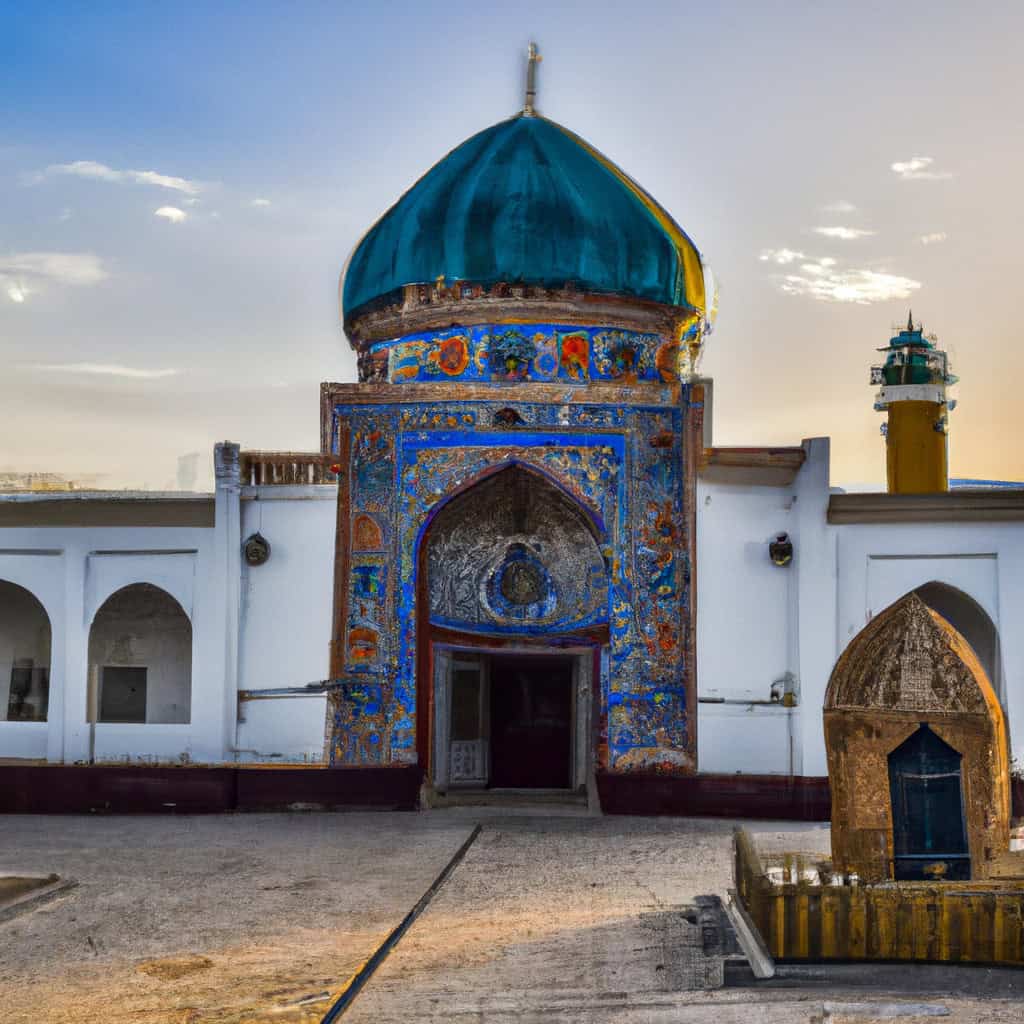Shrine of the Cloak Kherqa Sharif in Kandahar City, is one of many fascinating sites that both foreign visitors and local tourists can explore while they visit Afghanistan and exploring Kandahar Province. Tucked away in the bustling streets of Kandahar City, this historical monument attracts scholars, history enthusiasts, and spiritual seekers. Its rich past and unique cultural significance make it an intriguing attraction for anyone interested in Afghanistan’s history and heritage.
The Shrine of the Cloak Kherqa Sherif is indeed a humble embodiment of Afghanistan’s religious fervor, political history, and collective hope. It’s unique in not just holding a significant artifact of Islamic history, the cloak of Prophet Muhammad, but also in marking pivotal events that have shaped the historical contour of the country.
Shrine of the Cloak Kherqa Sharif Most Important Events
- The Safekeeping of the Sacred Cloak: The shrine majorly gained its recognition when Amir Sher Ali Khan, in 1863, brought the cloak of Prophet Muhammad to Kandahar for safekeeping. This precious relic has been protected here ever since.
- Claiming Legitimacy by King Nadir Shah: In 1935, Afghan King Nadir Shah used the cloak to legitimize his rulership. The cloak was displayed to the masses, which significantly established his reign.
- The Taliban’s Stance: The cloak’s display to endorse the Taliban’s rule in 1996 was another momentous event that testified the pivotal influence of the shrine in Afghanistan’s political trajectory.
History of Shrine of the Cloak Kherqa Sharif in Kandahar City
The Shrine of the Cloak Kherqa Sharif has a layered narrative dating back to the time of Amir Sher Ali Khan. He received the Prophet Muhammad’s cloak as a gift from Emir of Bukhara and placed it in Kandahar for protection during tumultuous times. The shrine was constructed around the cloak, and it became a sacred site, gaining religious and political significance over time.
In 1935, the Shrine of the Cloak Kherqa Sharif, undesirably, became a symbol of political legitimization. King Nadir Shah displayed the cloak to the masses to establish his rule, and subsequently several other rulers, including the Taliban in 1996, followed suit, reiterating the shrine’s undeniable influence on Afghan politics and society.
Fast forward to today, the shrine remains a testimony of this complex historical narrative. Even though access to the cloak is highly restricted, the Shrine of the Cloak still attracts thousands of visitors each year, reverberating with the echoes of its rich history.
Why It’s Important to Afghan History
The Shrine, through its storied past, has become an emblem of Afghan history, bridging the divides of politics and religion. Every ruler who sought to display the cloak to assert his rule was indicative of the shrines’ immense influence in shaping the fabric of Afghan society and its political landscape.
Moreover, the shrine manifests the quintessential Afghan spirit of preserving its cultural and religious relics amidst years of turmoil. The cloak, though rarely shown, is a symbol of faith for many, reinforcing the Shrine’s significance.
Why to Visit Shrine of the Cloak Kherqa Sharif
While its historical and religious significance is integral, the Shrine of the Cloak Kherqa Sharif offers more to its visitors. Its architectural grandeur, marked by intricate Islamic patterns, robust wooden doors, and the tranquil ambiance, is a sight to behold. The shrine stands as a symbol of serenity amidst the bustle of Kandahar city.
Stepping inside the shrine, visitors experience an overwhelming sense of peace. The quiet corridors, the feeling of being close to a cherished relic, and the profound spiritual ambiance of the place offer a tranquil escape.
- The architectural beauty of the shrine
- The serene and spiritual ambiance
- The historical significance of the cloak
- The bustling location in Kandahar city
- The chance to partake in Afghani culture and history
Ideally located in Kandahar City, the Shrine is easily accessible to visitors. The best time to visit the shrine is during the morning hours to absorb the serene vibe of the place.
Cultural & Tourist Significance
The Shrine of the Cloak Kherqa Sharif is undeniably woven into the colorful tapestry of Afghan culture. Its mere existence resonates with Afghan resilience and their profound attachment to their religious and historical heritage. This makes the shrine a must-visit for those wishing to understand Afghanistan beneath its surface.
The shrine is not only a religious spot but also a significant cultural landmark. Many local festivals and religious observances held there add to the cultural richness and diversity of the place, making it a living heritage site.
Being a blend of spiritual, historic and architectural wonder, the shrine serves as a unique destination for tourists. It showcases a narrative of Afghan history – from the arrival of the sacred cloak, the rulers who held it, to the common people who treasure it. Hence, a visit provides an enriching experience and valuable insights into Afghan society.
Interesting Facts
Legend has it that every time a ruler has displayed the cloak to establish his rule, it led to his fall. This myth is so pervasive that locals often discuss it in hushed tones, adding an element of intrigue to the shrine.
Despite its long-standing existence, the cloak has been displayed very few times, and its glimpses have always marked significant historical events, making it an enigmatic object of deep reverence and curiosity for many.
What’s unique about this shrine is how it has remained politically neutral over centuries. While rulers have used it as a power symbol, it didn’t alter the shrine’s inherent religious significance or its standing as a place of calm and contemplation for the visitors.
Embedded in the heart of Kandhar City, the Shrine of the Cloak Kherqa Sharif weaves a narrative that is unique and captivating, and that’s precisely what makes it a must-visit. It stands as a testament to Afghanistan’s rich past and resilience, offering a glimpse into the country’s spiritual soul, historical significance, and architectural richness.

